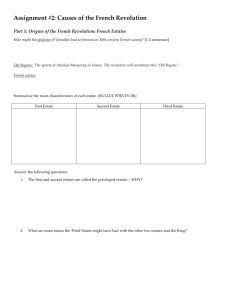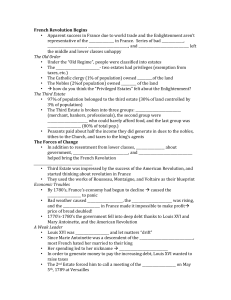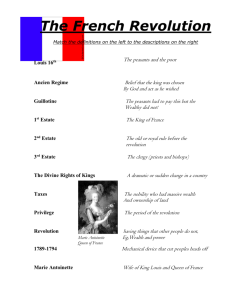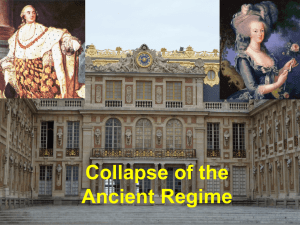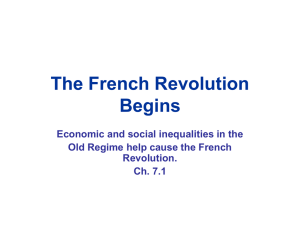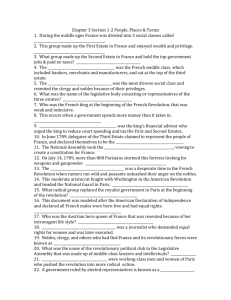The French Revolution of 1789 PowerPoint Presentation
advertisement
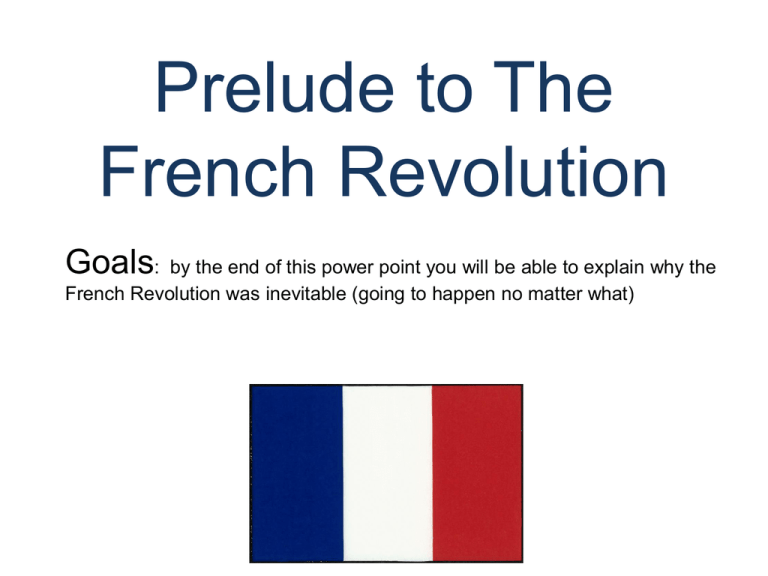
Prelude to The French Revolution Goals: by the end of this power point you will be able to explain why the French Revolution was inevitable (going to happen no matter what) © Student Handouts, Inc. www.studenthandouts.com The Old Regime (Ancien Regime) • Old Regime – sociopolitical system which existed in most of Europe during the 18th century • Countries were ruled by absolutism – the monarch had absolute control over the government • Classes of people – privileged and unprivileged – Unprivileged people – paid taxes and treated badly – Privileged people – did not pay taxes and treated well Society under the Old Regime • In France, people were divided into three estates – First Estate • High-ranking members of the Church • Privileged class – Second Estate • Nobility • Privileged class – Third Estate • Everyone else – from peasants in the countryside to wealthy bourgeoisie merchants in the cities • Unprivileged class The Three Estates Estate First Population Privileges Exemptions •Collected the tithe •Censorship of the press •Control of education •Kept records of births, deaths, marriages, etc. •Catholic faith held honored position of being the state religion (practiced by monarch and nobility) •Owned 20% of the land •Paid no taxes •Subject to Church law rather than civil law •Moral obligation (rather than legal obligation) to assist the poor and needy •Support the monarchy and Old Regime •Paid no taxes •Support the monarchy and Old Regime •Nobles •Collected taxes in the form of feudal dues •Monopolized military and state appointments •Owned 20% of the land •Circa 25,000,000 •None •None •Paid all taxes •Tithe (Church tax) •Octrot (tax on goods brought into cities) •Corvée (forced road work) •Capitation (poll tax) •Vingtiéme (income tax) •Gabelle (salt tax) •Taille (land tax) •Feudal dues for use of local manor’s winepress, oven, etc. •Circa 130,000 •High-ranking clergy Second Third •Circa 110,000 •Everyone else: artisans, bourgeoisie, city workers, merchants, peasants, etc., along with many parish priests Burdens What does this political cartoon say about conditions in France under the Old Regime? Economic Conditions under the Old Regime • France’s economy was based primarily on agriculture • Peasant farmers of France bore the burden of taxation • Poor harvests meant that peasants had trouble paying their regular taxes – Certainly could not afford to have their taxes raised • Bourgeoisie often managed to gather wealth – But were upset that they paid taxes while nobles did not France Is Bankrupt • The king (Louis XVI) lavished money on himself and residences like Versailles • Queen Marie Antoinette was seen as a wasteful spender • Government found its funds depleted as a result of wars – Including the funding of the American Revolution • Deficit spending – a government spending more money than it takes in from tax revenues • Privileged classes would not submit to being taxed Long-term Causes of the French Revolution • Absolutism • Unjust socio-political system (Old Regime) • Poor harvests which left peasant farmers with little money for taxes • Influence of Enlightenment philosophes • System of mercantilism which restricted trade • Influence of other successful revolutions • England’s Glorious Revolution (16881689) • American Revolution (1775-1783) Short-term Causes of the French Revolution Bankruptcy • Caused by deficit spending • Financial ministers (Turgot, Necker, Calonne) proposed changes • But these were rejected • Assembly of Notables voted down taxation for the nobility in 1787 Great Fear • Worst famine in memory • Hungry, impoverished peasants feared that nobles at EstatesGeneral were seeking greater privileges • Attacks on nobles occurred throughout the country in 1789 Estates-General • Louis XVI had no choice but to call for a meeting of the EstatesGeneral to find a solution to the bankruptcy problem • All three estates • Had not met since 1614 • Set in motion a series of events which resulted in the abolition of the monarchy and a completely new sociopolitical system for France Meeting of the Estates-General: May 5, 1789 • Voting was conducted by estate – Each estate had one vote – First and Second Estates could operate as a bloc to stop the Third Estate from having its way ◊ First Estate + ◊ Second Estate - vs. - ◊ Third Estate • Representatives from the Third Estate demanded that voting be by population – This would give the Third Estate a great advantage • Deadlock resulted Tennis Court Oath The Third Estate declared itself to be the National Assembly. Louis XVI responded by locking the Third Estate out of the meeting. The Third Estate relocated to a nearby tennis court where its members vowed to stay together and create a written constitution for France. On June 23, 1789, Louis XVI relented. He ordered the three estates to meet together as the National Assembly and vote, by population, on a constitution for France. Tennis Court Oath by Jacques Louis David
